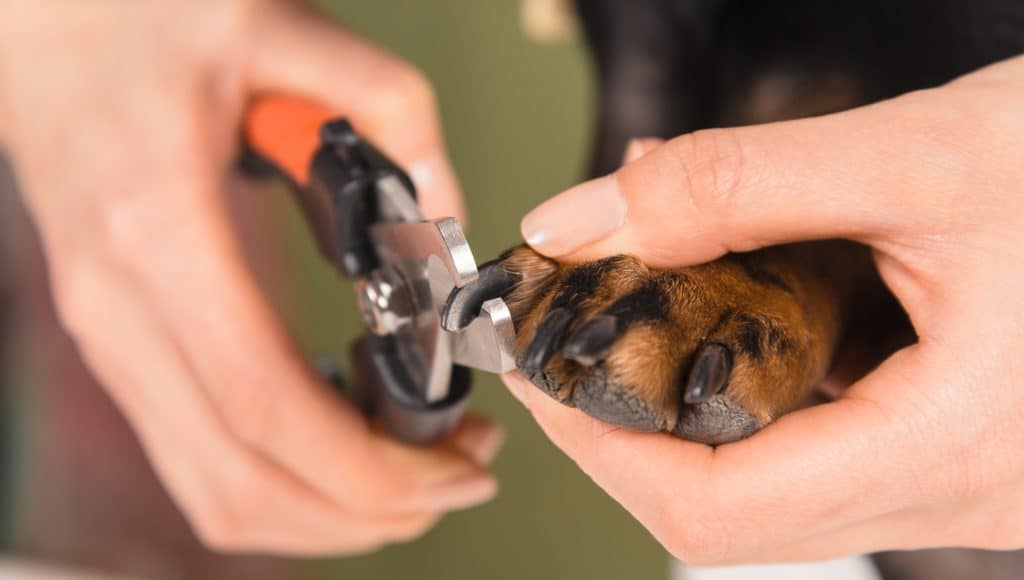Genetic diseases are one of the most severe ailments in human beings. They are like an embedded genetic mutation that is inherited and the worst part about them is that it is undetectable till the body achieves significant cases. The same thing is with your favorite beings i.e. your labs. One such genetic disease is Progressive Retinal Atrophy (PRA).
Atrophy simply means partial of complete wastage of a body part. This means that this disease deteriorates the affected organ and in this case, it is the retina. But what is the retina and why is it so important.

Retina and its Significance
To understand the significance of the retina we will first have to study the structure of an eye.
The eye consists of Lens, Retina, Iris, Cornea, and Optic nerve. But what is the function of the Retina? The retina is a thin photo-sensitive layer at the back of your eye which is like a movie theatre screen that depicts the whole picture. The light which passes through the lens is converted into an electrical signal at the retina and then it is sent to the brain via optic nerves.
The retina consists of two cells-Rods and Cons. Rods are responsible for detecting movement and night (low light) vision. Cons are responsible for detecting colors. Human beings have more Cons than Rods and it is the opposite in the case of dogs because traditionally dogs were wild animals. So it is these photoreceptor cells that make vision possible.
In PRA, these rods and cons get deteriorate over time causing partial or complete blindness. PRA is actually a group of the degenerative disease slowly degrades the retinal layer hence it got “progressive” in its name.
Types of Progressive Retinal Atrophy
PRA are of two types – GPRA and CPRA.
Generalized Progressive Retinal Atrophy
This is the most common atrophy in dogs. It can occur at any age- young or old. The onset of GPRA results in the improper formation of rods and cones which make dogs difficult to see. In the later phase, the deterioration of rods and cons takes place which results in complete vision loss. This form of blindness goes unnoticed until the age of three or four. It can be diagnosed only when the hereditary condition starts exhibiting the signs of impairment.
Breed that may suffer from GPRA includes:
- Akita
- Alaskan Malamute
- American cocker spaniel
- Belgian shepherd
- Briard
- Cardigan Welsh Corgi
- Dachshund
- Labrador Retriever
- Siberian Husky
- Tibetan Terrier
And some others.
Central Progressive Retinal Atrophy
This Is a less common form of atrophy in dogs. It is also known as retinal pigment epithelial dystrophy (RPED). This rare type of eye disease causes the pigmented layer of the retina to degrade and therefore making it difficult to see in dark or low light. This takes place at old age and doesn’t result in complete vision loss.
Breed that may suffer from CPRA includes:
- Border Collie
- Golden Retriever
- Labrador Retriever
- Shetland Sheepdog
You can clearly see that the Labrador retriever is the most vulnerable breed and is included in both the list hence if you are a Labrador owner then you should read this whole article for betterment. Also, the European Breeds have a higher incidence rate because of gene mutation.
Ok! But how fast does it develop
PRA takes time to develop and the process is a little slow. Generally, it takes a couple of years for complete blindness. Though the speed and development completely depend on the breed of dogs 1-2 years is the generalized time frame.
But how will I know if my dog is suffering from it?
Here is the list of signs that can tell you if your dog is suffering from PRA.
1) Night blindness
Night blindness is one of the most crucial signs to self diagnose this condition. If your dog is hesitating to go into a darker place then it can be a sign of PRA. It firstly affects the ability to see in the dark so noticing small things can help the owners to detect this problem at a younger age.
2) Unable to find toys
We all know that dogs love to play, especially if they have some soft or squeaky toys around them. But the inability to find a toy in close proximity can be a sign of PRA. So next time if you are playing with your lab and it’s unable to find toys then rush to the vet.
3) Difficulty in Bright lights
PRA slowly reduces the capability of eyes and the flashy lights or sharp light may disturb your lab. PRA affects the night vision first and gradually decreases the capability of day vision. Pet owners with dogs that are developing PRA observe that their pet’s eyes have become very reflective when light shines on them and that the pupils are more dilated than normal. So if your dog is in distress or is behaving abnormally under bright light then consult the vet as soon as possible.
4) Unable to follow hand signals
If your lab is unable to follow hand signals then there is some serious problem in their eyes and you should immediately address that problem. Consult a vet and diagnose the problem as soon as possible.
5) Bumping into objects
Bumping into objects is another crucial sign. These signs are quite observable during the night. This simply means that they are not able to percept properly. The ambiances in their eyes are not anymore adjustable. If your lab is feeling clumsier and uncomfortable and is hitting many objects on their way then go to the vet for confirmation.
6) Vision loss
Vision loss is the consequence of the prolonged deterioration of eye cells. This is the culminating sign which is incurable. Although the entire process is incurable at least owners get time to understand the situation but the sudden vision loss creates anxiety amongst the owners.
Diagnosis for Progressive Retinal Atrophy in Dogs
There are two main methods by which vets diagnose the disease i.e. electroretinography and genetic testing. The preliminary test includes the view of the retina through indirect ophthalmoscope and the signs are mentioned above. Now, let us see the types of method that are actively used to confirm this disease.
1) Electroretinography
You might find it similar to Electrocardiogram (ECG) and yes it is similar to that. They both work on the same principle i.e. they both produce the electrical impulse to find the flaw in the organ of interest and in this case it is the eye. The procedure is extremely agile but the prognosis after it is quite remarkable.
A contact lens is placed on the cornea (these lenses are specially made for retinography and are strictly graded) and two electrodes are placed under the skin around the eye (this is not painful but the size of electrodes are small and don’t cause any significant problem). Then the lights are switched off and after a period of adaptation, light flashes are used to stimulate the retina.
The electrical response is recorded by the electrodes, which send a signal to a computer. These electrodes are very sensitive and can capture even the smallest deflection. A healthy retina will produce a characteristic wave pattern on the electroretinographic recording. These recordings are interpreted by the vet and can confirm the disease.
Every medical complication can pose some risk but thankfully the risk revolving around ERG is low. But some complications may occur after this test so it is advisable to stay in touch with the vet and other medical professionals if your dog is showing anomalous behavior.
2) Genetic testing
This type of testing is much feasible and less invasive. It requires a blood sample and using that effective gene testing can be initiated. The collected samples are sent to the lab for testing as PRA is an inherited disease. The blood is revolutionary because it can not only detect the dogs that are affected but also the ones who may pass the defective genes to their offspring. But the drawback of this test is that not all breeds are eligible for it. Only in some breed, in which PRA is common, gene testing is possible. You can see that list above.
What is the treatment?
Unfortunately, PRA is not curable though many vitamin therapies and antioxidants are available no significant progress has been achieved through it. Vitamins and antioxidants are useful if your lab is suffering from some other problems like cataract and retinal detachment, but it is ineffective in combating PRA.
According to the University of Michigan’s 2017 study, Gene therapy may offer dogs with PRA a cure by introducing a normal copy of the CNGB1 gene, but this is not a widely available, so more advancements in this field are awaited.
Do I need to worry?
This might sound derogatory but you should not worry about your dog’s future. We will tell you why. Eyes are the third most significant organ for dogs are Nose and Ears. Also, PRA is a slow phenomenon and dogs get enough chance to memorize their environment.
The vision loss is not painful but the idea of vision can be! Your lab may get chill and roam around as nothing has happened but you can be in grief. Living with a blind dog is not at all inconvenient. You can teach certain voice commands to your lab and while wandering out you can use lease for added safety.
Prevention
Selective breeding is the only possible way to prevent the spread of PRA. Since it is an inherited disease, offspring can get it from their parents. So, you should not breed your dog if they have symptoms of progressive retinal atrophy.
Conclusion
Living with a blind dog can be a nightmare for the owners but understand that is neither painful nor different for your lab. They depend more upon their nose and ears so life is pretty much possible after vision loss. Make sure you do not breed your dog if they are suffering from PRA because the mutation will continue and can affect progenies.
Dogs are very emotional beings and are attached to their owner. It is your responsibility to make sure that you are around them when they need you the most. Do not abandon them or send them to any pet care. If you decide to groom a pet then it is your moral responsibility to take care of it with all your heart and soul. As long as you have a good attitude towards your dog’s condition and encourage him to remain an active participant in the home, most affected dogs remain happy. Check for the symptoms in your dog and be ready for the future. Don’t get dejected after the news of PRA as it might be incurable but the bond between you and your lab is eternal!
Table of Contents


